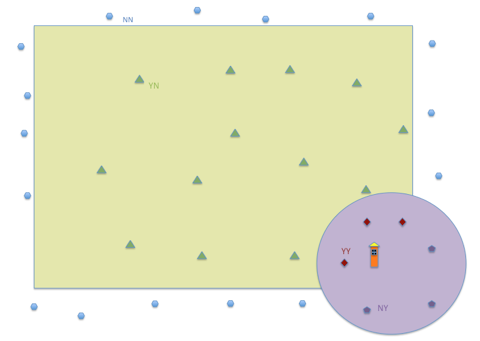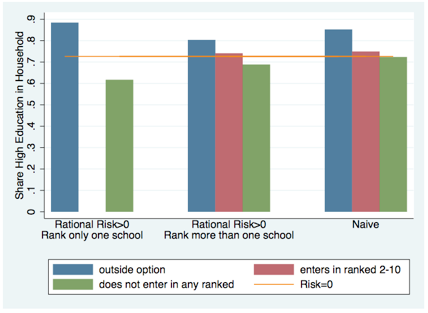Are parents really picking their preferred schools or merely going the safe route? In their BSE Working Paper (No. 810), “The Illusion of School Choice: Empirical Evidence from Barcelona,” Caterina Calsamiglia and Maia Güell show that Barcelona’s school choice program leads parents to effectively pick a neighborhood-based schooling assignment for their children, and that some parents are not as naïve is they may seem.
The Boston Mechanism and Preference Trade-Offs
Over in Barcelona little Jordi is gearing up to go to school and his parents have finally received the form they must fill out. They have to pick their top 10 preferred schools throughout Barcelona where they want Jordi to spend the next several years getting his primary education. They know this decision is important as the quality of schooling he gets now can affect him for years to come. But there’s a problem: their most preferred schools are not in their neighborhood, and the point system used to overcome over-demanded schools gives priorities to those who live in the neighborhood. Unfortunately others will want to send their kids to these good schools and Jordi’s parents know this. So should they apply for these good schools and try to get Jordi the best education, with the risk that if he doesn’t get into any of them they lose control; or play it safe and apply to their neighborhood schools?
This dilemma is what Calsamiglia and Güell set out to study. For the past two decades many OECD countries have moved toward school choice mechanisms that aim to improve the math between students and schools and educational outcomes, with the most widely used being the Boston Mechanism (B-Mechanism). This mechanism works by assigning students to their first-ranked school, with ties for over-demanded schools broken through priority points. Unresolved matches enter a next round until a seat is found.
However, the process greatly reduces the chances of entering into the subsequently ranked schools so picking the first-ranked school is crucial, as Table 1 below shows.

The presumption of the B-Mechanism is that final assignment reflects parental preferences. However, as Jordi’s parents’ dilemma portrays, this may not always be the case and the B-Mechanism has come under scrutiny. Others who have looked at the B-Mechanism have noted that it’s rarely optimal for parents to declare their true preference, since their choice depends on other parents’ choices. This leads to a trade-off between stating one’s true preference and playing it safe. Priority points, however innocuous they may seem, may affect parents’ behavior by inducing this trade-off behavior. In Barcelona neighborhood schools are given higher priority points. And as Table 1 further shows, the proportion of families picking neighborhood schools as their first choice is quite large.
Unexpected Change in Defined Neighborhood is Key
Table 1 shows that in any given year, around 80 percent of families apply for a neighborhood school. But by observing parents’ choices at a point in time, one cannot identify whether this behavior results from families’ preferences for the neighborhood schools or from families applying for a safer school. The authors exploit an unexpected change in the definition of neighborhood occurring in 2007 to assess whether it is preferences or safety that drives parents’ school choice. Crucial for the analysis is that the set of schools families have priority for changed with this new definition of neighborhood, and that this change was exogenous to families. The key insight is that if parents choose according to their preferences, then a change in neighborhood definition should not systematically change their choices. Instead, if parents play it safe, then a change in neighborhood definition may affect their choices.
The analysis focuses on families’ schools ranked first and find that after the change in neighborhood definition, families avoid applying for the old neighborhood schools and apply to the new neighborhood schools. In order to illustrate these changes we classify schools for each family as follows:
- Yes-Yes Schools (YY hereafter): in the old neighborhood and in the new neighborhood.
- Yes-No Schools (YN hereafter): in the old neighborhood but not in the new neighborhood.
- No-Yes Schools (NY hereafter): not in the old neighborhood but in the new neighborhood.
- No-No Schools (NN hereafter): not the old neighborhood and not in the new neighborhood.
The following picture illustrates this classification for a family living at the corner of the old neighborhood. Diamonds, pentagons, triangles, and hexagons in these graphs represent schools. The (orange) building is a particular family/address. The (green) square represents the old neighborhood, and the (purple) circle refers to the new neighborhood.

If families play it safe, the change in behavior should be such that they stop ranking first schools that are no longer in their neighborhood. Consequently, the proportion of families that ask for YN schools should decrease between 2006 and 2007, which is exactly what we observe in Table 2. The proportion of families that ask for YN schools was reduced from 21 percent to 10 percent, which is a decrease in demand of 52 percent.
Moreover, if families play it safe, the change in behavior should be such that they start ranking first schools that are in their new neighborhood, because these schools now give them priority points. Hence, the proportion of families that ask for NY schools should increase between 2006 and 2007, which is exactly what we observe in Table 2. The proportion of families that ask for NY schools increased from 9 percent to 17 percent, which is an increase in demand of 89 percent. This very large increase indeed suggests that safety, rather than parents’ preferences, plays a crucial role in choosing a school.

This implies that the gains of school choice in terms of matching of children and schools seem limited, because the equilibrium allocation is not very different from that without choice, where children are assigned automatically to their neighborhood school.
The Consequences of Unwarranted Risk: Naïve Parents and the Outside Option
To understand the consequences of parents’ choices the authors next analyze the risk of choosing the schools ranked first and second to understand possible naïve behavior: applying for a school when there’s almost 0 probability of entering it. This is important to understand since others have argued that the B-Mechanism may raise equity concerns, specifically, that disadvantaged parents may not understand the mechanism and thereby play non-strategically.
The authors claim that while 40% of families who face some positive risk of not obtaining their first choice seem a large share, 91% of these families demand a school in their neighborhood. In an equilibrium where most families play it safe the risk is borne by those seeking a neighborhood school. Further, almost 2% of families across all the data rank as their first choice a school for which they have 0% chance of entering. Are they naïve? To answer that question the authors next look at the risk of not entering the second-ranked school. Here they find that 23% of the 42% in the table are possibly naïve. And to get an insight as to the composition of these families a look at final enrollment must be taken.
It turns out that 14% of those classified as naive enroll their child in either a private school or in a school outside of Barcelona – that is, they enact an outside option. So these families are not naïve at all but using the system to their advantage. Moreover, 32% of those with an outside option rank only 1 school and leave the rest of the application incomplete.
By merging the datasets with those of the Catalonian census and Barcelona civil registries the authors can match the applicants to their parent’s information to get a socio-economic understanding of these families who do not enter into their first-ranked school. As portrayed in Figure 2 below those families that can exercise an outside option have generally higher education; while the families that don’t enter into any of their ranked schools have in general lower education – with the biggest educational divide among those that only rank one school.

Why are these low education families not entering into any of their ranked schools? One explanation is that they don’t completely understand how the system works. Another is that they live in worse neighborhoods with systematically under-demanded schools. So they take the risk of applying to the best school(s) in the system since they can’t do any worse – in a similar but opposite manner as their outside option brethren, these families have nothing to loose going all out since at worst their children end up in one of their neighborhood schools.
The equity issue here is not only that disadvantaged families can’t exercise choice. But rather an outside option induces parents to take risks since they’re able to exit the system altogether if the results don’t go their way. These families have, in fact, more access to the best schools.
Why then the B-Mechanism?
It turns out that Jordi’s parents probably can’t do any better than selecting a neighborhood school, since this is what others are doing. If they apply for the best schools, which happen to be outside of their neighborhood, they run the risk of not getting into any of them since parents in those neighborhoods are also picking those schools. Unless Jordi’s parents lined up a private school they’re willing to send him to, this may not be the best route to go in Barcelona’s implementation of the B-Mechanism.
The main issue is that parent’s choices are being driven by the priority point system, which induces a trade-off behavior when parents make their school choices. In effect it works out to be no better than a traditional neighborhood allocation system. So whatever efficiency gains might be obtained from the B-Mechanism’s matching of students with their schools is undermined by the presence of private schools and a priority system.


